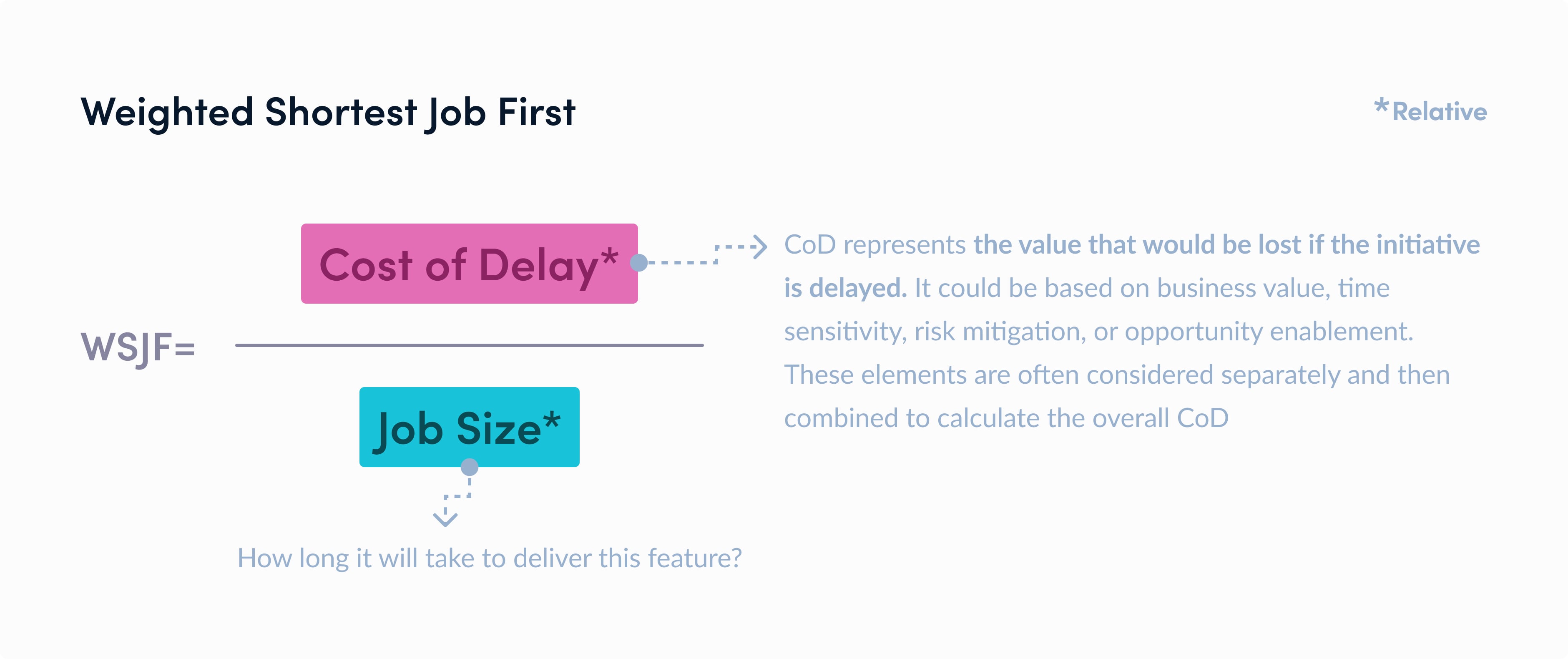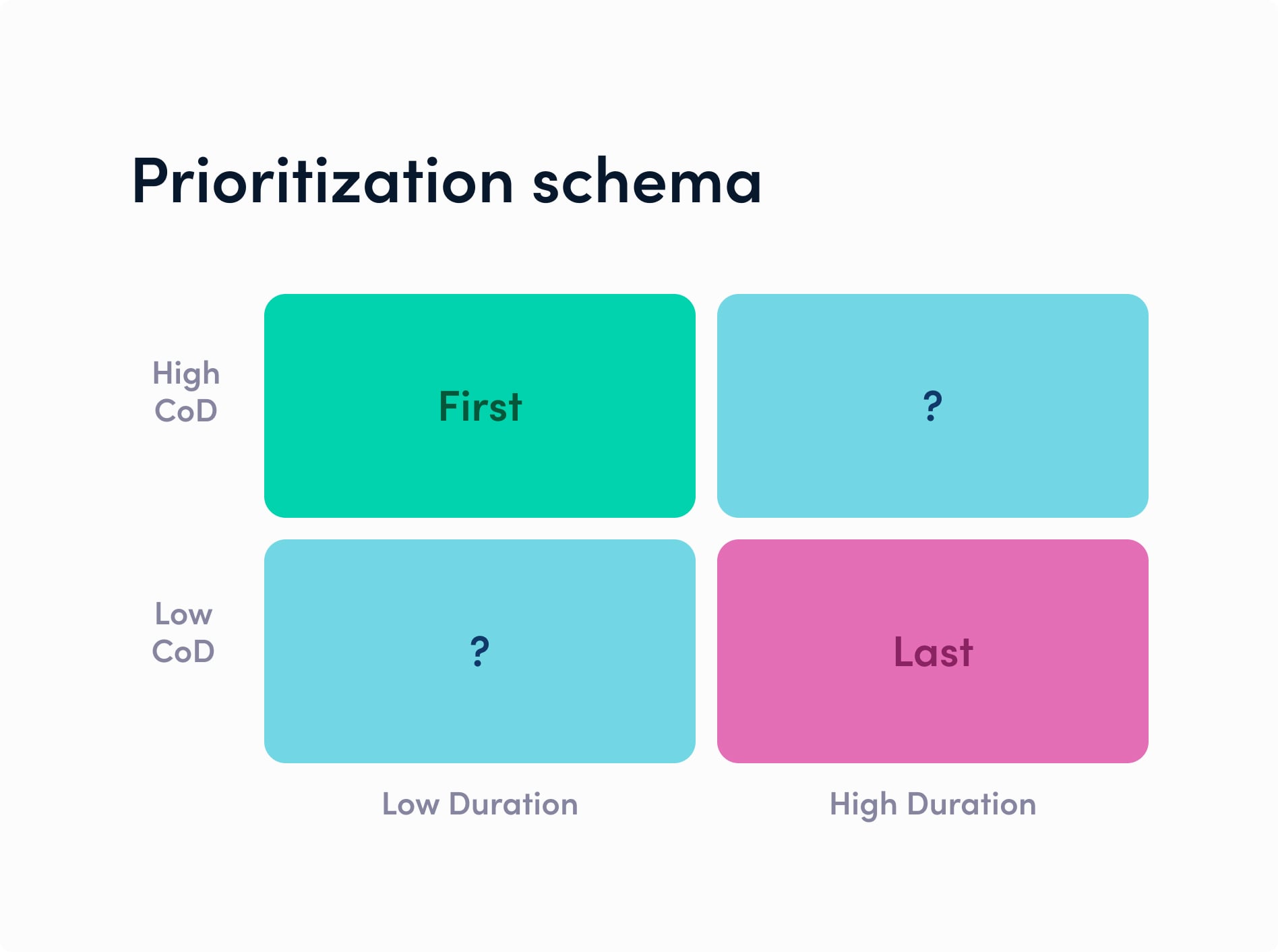Updated: June 24, 2025- 6 min read
Applying the Weighted Shortest Job First method is the best way to optimize the product backlog for value. As you or your team decide which feature to prioritize next, consider using the WSJF to balance the Cost of Delay against the fastest time to completion.
Prioritizing with Weighted Shortest Job First in Agile Projects
Agile is a Product Development methodology with a focus on flexibility, learning, and delivering customer value.
The adoption of Agile methodologies has revolutionized how organizations plan, execute, and deliver value. It empowers teams to discern and sequence work based on its value and impact. It ensures that teams are not just doing the work right but are doing the right work.

Amidst the myriad tasks, features, and enhancements clamoring for attention within Agile frameworks, the crucial question arises: how does one prioritize effectively to ensure maximum value delivery in minimal time? Enter Weighted Shortest Job First (WSJF) Agile, a strategic prioritization technique that seamlessly aligns with Agile's core principles.
WSJF takes Agile to the next level by combining existing prioritization methods to incorporate a holistic view of the urgency and value of a given feature in the product backlog.
Product Roadmap Template
Download our easy-to-use template to help you create your Product Roadmap.
Get the Template
WSJF explained: What is WSJF prioritization?
The WSJF formula is the ratio of the "Cost of Delay" (CoD) to the job duration. The idea behind WSJF is simple: do the easiest and most impactful features or tasks first and leave the lowest impact initiatives that take a long time to the end.

Why should you apply weighted shortest job first?
By definition, WSFJ ensures teams prioritize work that delivers the highest value in the shortest time. By evaluating factors like business value, time criticality, and risk reduction, WSJF ensures that the most impactful features start generating value as quickly as possible, enhancing efficiency in Agile environments.
WSJF's Role in Scaled Agile Framework (SAFe) and Lean Practices
WSJF enhances Lean's focus on eliminating waste and optimizing processes by ensuring that resources are allocated to work that maximizes customer value and minimizes time to market, reinforcing the principles of Lean thinking and Agile execution at scale.
Best practices for implementing WSJF in Agile projects, particularly when integrating with the Scaled Agile Framework (SAFe):
Commitment to continuous improvement
A culture that values empirical data over intuition
Incorporating WSJF scoring during backlog refinement sessions and sprint planning
Engaging the whole team in WSJF scoring to make sure the value reflects everyone’s point of view
Iterate and adapt as new new information emerges and project dynamics evolve
Visualize the prioritization with boards and dashboards to make it transparent and easy to understand
Design Sprint Template
Use design thinking to solve design problems and reduce production risks.
GET THE TEMPLATE
WSFJ scoring and calculation
Understanding the WSJF formula and its components is crucial for effective Agile prioritization.
How to calculate WSFJ
WSJF Score = CoD / Job Size
Teams can use the above calculation for a series of tasks, a feature release, or an entire product.
The components of the WSFJ framework
Cost of Delay
[Quote: You don’t want to prioritize your projects to start slowly and accelerate at the end. You want them to ramp up early and taper off to minimize the Cost of Delay. —Don Reinertsen, The Principles of Product Development Flow]
Cost of Delay (CoD) underscores the importance of timely delivery by quantifying the economic impact of delays. To calculate CoD, each of the following factors is assigned a score based on a modified subset of the Fibonacci sequence:
Value to Business/User: Measures both tangible and intangible benefits a task offers.
Time Criticality: Assesses urgency, highlighting tasks where delays would lead to significant value loss.
Risk Reduction/Opportunity Enablement: Evaluates a task’s potential to mitigate future risks or seize upcoming opportunities.

Using the Fibonacci Sequence: This sequence aids in assigning relative values to the CoD components, promoting consistent and fair comparisons by focusing on proportion rather than precise figures.
The scale is as follows: 1, 2, 3, 5, 8, 13, 20

Important: When comparing different tasks within each category, the smallest item equals 1. Each category must have one item with a value of 1.
Based on the smallest value, estimate the other values. So, if the next most valuable task is roughly 3 times as value, that task gets a value of 3. If the next task is 3 times the value of that one, it gets a value of 8, and so on.
Job size
Estimating job size is about quantifying the effort required for a task, pivotal for balancing the CoD. Key points to consider include:
Relative Sizing: Use the same subset of the Fibonacci Sequence above to ensure you compare relative sizes.
For example, if you have three tasks, one that you estimate will take 2 weeks, one that will take 4 weeks, and one that will take 3 months, the values assigned to those would be 1, 2, and 5.
Consensus-Based Estimation: Make sure every team member gets a say and can contribute their unique perspective.

WSJF Example Use Case
Let's explore a hypothetical use case within a bank undergoing digital transformation. The bank aims to enhance its digital services, focusing on three key projects: implementing an advanced online banking platform, integrating blockchain for secure transactions, and deploying AI chatbots for customer service.
Task 1: Implementing an Advanced Online Banking Platform
Value to Business/User: 8 (High value due to expected customer satisfaction and retention)
Time Criticality: 5 (Moderate urgency to stay competitive)
Risk Reduction/Opportunity Enablement: 3 (Moderate risk reduction by offering more secure and diverse online services)
Job Size: 13 (Significant effort required for development and integration)
WSJF Score: 8+5+3/13≈1.23
Task 2: Integrating Blockchain for Secure Transactions
Value to Business/User: 5 (Enhances security, but with uncertain customer demand)
Time Criticality: 3 (Not immediately critical, but important for long-term strategy)
Risk Reduction/Opportunity Enablement: 8 (High due to significant improvement in transaction security and fraud reduction)
Job Size: 8 (Requires specialized skills but less comprehensive than a platform overhaul)
WSJF Score: 5+3+8/8=2.00
Task 3: Deploying AI Chatbots for Customer Service
Value to Business/User: 3 (Improves efficiency but might not be the primary demand of users)
Time Criticality: 2 (Low urgency, as current customer service channels are adequate)
Risk Reduction/Opportunity Enablement: 5 (Moderate opportunity to lead in customer service innovation)
Job Size: 5 (Relatively smaller project, leveraging existing AI technologies)
WSJF Score:
3+2+5/5=2.00
Task 2 (Blockchain Integration) and Task 3 (AI Chatbots) should be prioritized over Task 1 (Online Banking Platform) due to their higher scores. In this way, the bank can balance innovation with practicality, focusing on projects that offer the best blend of value, urgency, and strategic importance relative to their size and complexity.
WSJF Agile Implementations: Key Takeaways and Benefits
Enhanced Prioritization: WSJF provides a clear, quantitative framework for prioritizing tasks, ensuring that the most impactful initiatives are addressed first.
Improved Stakeholder Alignment: By making prioritization criteria transparent, WSJF fosters alignment among stakeholders, facilitating more informed decision-making.
Increased Agility: Organizations report greater flexibility in responding to market changes, as WSJF enables them to quickly pivot to high-value tasks.
Optimized Resource Allocation: By focusing on high-value, time-sensitive tasks, companies optimize their use of resources, avoiding waste on low-impact activities.
Playbook: The Dangers of Staying Safe
Check out insights from Mastercard Gateway CPO to help you battle cumbersome processes and become truly Agile.
GET THE PLAYBOOK
Updated: June 24, 2025





